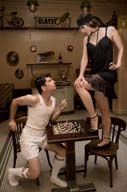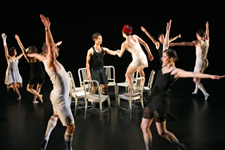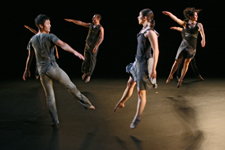
Jack Anderson
Dusan Tynek's Choreographic Environments
Dusan Tynek Dance Theatre
Dance Theater Workshop, 219 West 19th Street, Chelsea
June 2-5 at 7:30 p.m., $25.
Tickets: (212) 924-0077 or www.dancetheaterworkshop.org
Reviewed by Jack Anderson, June 4, 2010
 |
| The Dusan Tynek Dance Theatre. Photo by Victoria Waldruff. |
The Dusan Tynek Dance Theatre has reasons to be happy. Its Czech-born choreographer-director devises lots of ardent steps that set his attractive dancers sweeping across the stage. His patterns are inventive without looking self-consciously so. And he has ideas. He obviously tried to provide each of his three premieres with its own choreographic personality. Yet I wish that "Middlegame," the most ambitious of those premieres, had possessed even more personality and had lived up to the publicity photo announcing it.
That photo showed part of a room resembling a kitchen or, more likely (since there was a sign for "Glaces" on the back wall), a café. A table with a chessboard and white and black chessmen arranged for a game stood in the center of the space. A man in white socks and underwear leaned forward from a chair at one end of the table to gaze at a seductive woman in a black slip who stood, looking very much the femme fatale, with one leg on a chair and the other perched on the tabletop. Here was a scene that promised, in addition to a game of chess, quite a bit of erotic game-playing. Perhaps this couple might not even bother about chess.
Both game-playing and a café setting were implicit in the dance. Dave Johnson, the costume designer, put four of Tynek's couples in black, while the other four wore white, and the stage was filled with chairs the dancers kept rearranging as they divided into factions vaguely recalling the disputatious artistic cabals associated with many French or Central European intellectual cafes. Unfortunately, the key word here is "vaguely."
 |
| "Middlegame." Photo by Julie Lemberger. |
The chess games, power struggles, and erotic couplings the photograph hinted at were diluted in the actual dance, although there were many scenes that could be admired for their choreographic ingenuity alone: for instance, a sequence in which dancers kept raising chair after chair so that a woman could cross the room by stepping on the chairs without touching the ground, or one in which dancers sitting facing one another became progressively infected with fits of trembling.
Nevertheless, these actions, despite the struggles in them, seemed strangely remote. "Middlegame" never appeared to take place in any sort of theatrical environment where its events might stir one's passions, as well as one's admiration for purely formal invention. If an elaborate décor of the sort associated with Pina Bausch would not have been necessary, the impact of "Middlegame" might have been intensified if it had occurred in a space in which its events really seemed to matter: after all, Lenin, James Joyce, and Tristan Tzara were all confirmed cafe sitters. An original, or at least a unified, score might also have helped. Tynek's potpourri of music ranging from Bach to Gypsy songs only made "Middlegame" too bitsy.
 |
| "Transparent Walls." Photo by Julie Lemberger. |
The most consistently impressive premiere was "Transparent Walls," to a score of that name by Aleksandra Vrebalov in which winds, cello, percussion, and celesta piled up layers (or walls, perhaps?) of sound as people kept emerging from what Roderick Murray's ominous lighting designs turned into a total darkness, or even a vast pit or black hole upstage. Yet when the lights illuminated the entire space, there was nothing up there but a plain back wall. Here, music and lighting united with Tynek's urgent choreography to create a sense of individuals emerging from and returning to the unknown.
An upstage metronome stood ticking away as the recorded voice of Lucinda Childs recited a text by Cynthia Polutanovich in "Base Pairs." The words were often intensely erotic (for instance, "Intimacy burns us down" and "Your strong thighs pressing me are how they have to be"), and they combined sensuality with religiosity: "Later that night your bed was a church house. A crucifix dangled over it by a string. Christ hung above us crowned with thorns….I looked up at Jesus hanging from a string, twisting in the breeze from the window, and said, 'What are you looking at?'"
What the audience looked at were rather mechanical steps for seven dancers, many involving big swings of the arms, as though these people were responding to the ticks, rather than to the highly charged text. Or perhaps they had lived through the experiences implied by the text and were emerging from them slightly dazed. Although, choreographically, "Base Pairs" occasionally threatened just to tick on and on, Tynek always managed to rewind it with renewed energy.
| museums | NYTW mail | recordings | coupons | publications | classified |
